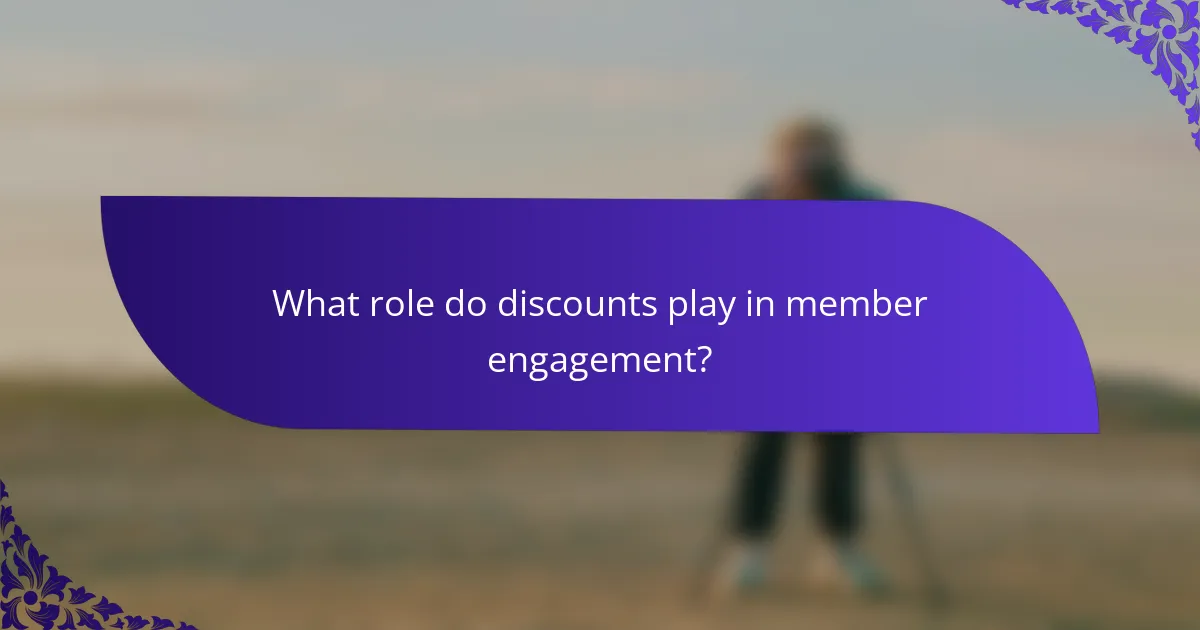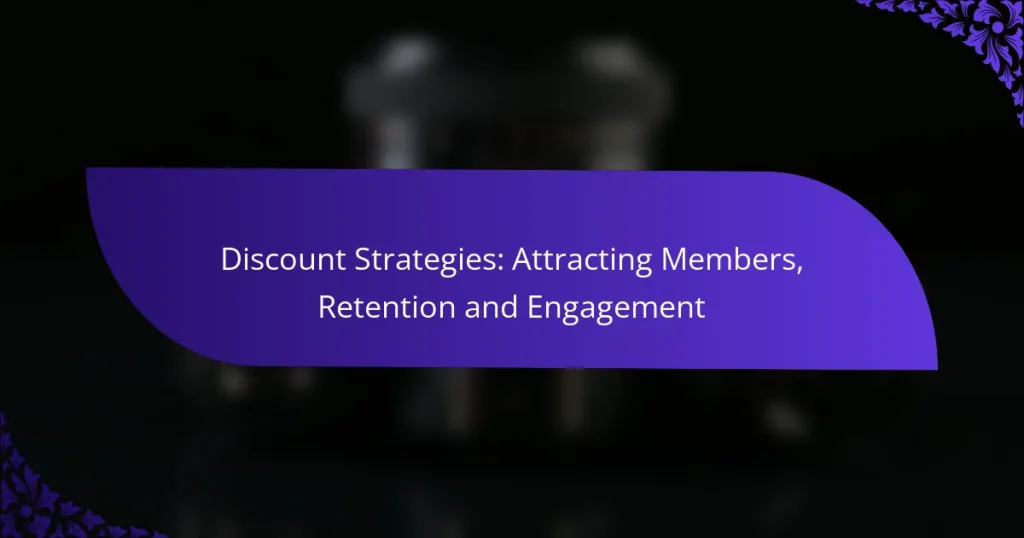Discount strategies play a crucial role in attracting new members and fostering long-term loyalty. By offering tailored promotions, organizations can enhance perceived value and encourage ongoing engagement, ultimately leading to increased member retention. These incentives not only motivate participation but also create a sense of satisfaction and loyalty among members.

What are effective discount strategies for attracting members?
Effective discount strategies for attracting members include various approaches that incentivize potential customers to join and engage with your offerings. These strategies can enhance perceived value and encourage long-term loyalty through tailored discounts and promotions.
Tiered membership discounts
Tiered membership discounts offer varying levels of savings based on the membership tier a customer selects. For example, a basic tier might provide a 10% discount, while a premium tier could offer 20% off. This structure encourages customers to opt for higher tiers to maximize their savings.
When implementing tiered discounts, consider the value proposition of each tier. Ensure that the benefits justify the cost, as this can significantly influence membership decisions. Regularly assess the effectiveness of these tiers to optimize engagement and retention.
Seasonal promotions
Seasonal promotions leverage holidays or specific times of the year to attract new members with limited-time discounts. For instance, offering a 15% discount during the holiday season can create urgency and drive sign-ups. These promotions can be tailored to local customs and shopping habits.
To maximize impact, plan your seasonal promotions well in advance and promote them across various channels. Consider using email marketing and social media to reach a wider audience, ensuring that your messaging aligns with the seasonal theme.
Referral bonuses
Referral bonuses reward existing members for bringing in new customers, creating a win-win situation. For example, offering a $10 credit for each successful referral can motivate members to spread the word about your services. This strategy not only attracts new members but also strengthens community ties.
To implement a referral program effectively, make the process simple and trackable. Use unique referral codes or links to monitor conversions, and consider offering additional bonuses for multiple referrals to encourage ongoing participation.
Limited-time offers
Limited-time offers create a sense of urgency that can drive immediate action from potential members. For instance, a 30% discount available for just one week can prompt quick decisions. These offers are particularly effective when tied to specific events or product launches.
Ensure that your marketing clearly communicates the time-sensitive nature of the offer. Utilize countdown timers on your website and in promotional emails to enhance urgency and encourage sign-ups before the offer expires.
Bundled service discounts
Bundled service discounts combine multiple services or products into a single package at a reduced rate, appealing to members looking for comprehensive solutions. For example, offering a package that includes three services for the price of two can enhance perceived value and increase sales volume.
When creating bundles, focus on complementary services that provide a cohesive experience. Clearly outline the savings compared to purchasing items separately, and promote these bundles through targeted marketing campaigns to attract new members effectively.

How can discounts improve member retention?
Discounts can significantly enhance member retention by providing tangible value that encourages ongoing engagement. By implementing strategic discounting methods, organizations can create a sense of loyalty and satisfaction among their members.
Loyalty rewards programs
Loyalty rewards programs incentivize members to continue their engagement by offering discounts or points for repeat purchases. These programs often operate on a tiered system, where members can unlock greater rewards as they spend more. For example, a program might offer 5% off for every $100 spent, with additional bonuses for reaching higher spending thresholds.
To maximize effectiveness, ensure that the rewards are attainable and appealing. Regularly communicate the benefits and progress to members, which can reinforce their commitment to the program.
Exclusive member-only discounts
Exclusive discounts for members create a sense of belonging and appreciation, encouraging them to stay engaged. These discounts can take various forms, such as percentage reductions on products or services, early access to sales, or special promotions during holidays. For instance, a gym might offer a 20% discount on membership renewals exclusively for existing members.
To implement this strategy effectively, ensure that the discounts are communicated clearly and frequently. Highlight the exclusivity to enhance the perceived value and encourage members to take advantage of these offers.
Personalized offers based on usage
Personalized offers tailored to individual member usage can significantly boost retention rates. By analyzing member behavior and preferences, organizations can create targeted discounts that resonate with specific needs. For example, a streaming service might offer a discount on a subscription upgrade based on a member’s viewing habits.
Utilizing data analytics tools can help identify trends and preferences among members. Regularly update and refine these personalized offers to keep them relevant and appealing, ensuring that members feel valued and understood.

What role do discounts play in member engagement?
Discounts are a powerful tool for enhancing member engagement by incentivizing participation and fostering loyalty. They can motivate members to interact more with a brand, leading to increased retention and satisfaction.
Incentives for feedback and reviews
Offering discounts in exchange for feedback or reviews encourages members to share their experiences. This not only provides valuable insights for improvement but also makes members feel valued and heard. For instance, a 10% discount on their next purchase can be an effective incentive for a detailed review.
To implement this strategy, consider setting clear guidelines on what type of feedback you seek. Ensure that the discount is appealing enough to motivate members but sustainable for your business model.
Discounts for participation in events
Providing discounts for attending events can significantly boost member participation. For example, offering a 15% discount on future purchases for attending a webinar or workshop encourages members to engage with your brand’s offerings actively.
When planning events, clearly communicate the discount benefits in your promotional materials. This not only attracts attendees but also enhances their overall experience, making them more likely to return.
Engagement through gamified discount systems
Gamifying the discount process can create a fun and engaging experience for members. Implementing a points system where members earn discounts based on their activities, such as referrals or social media shares, can drive engagement and loyalty.
Consider using a tiered rewards system where members unlock greater discounts as they accumulate points. This encourages ongoing participation and keeps members invested in your brand over time.

What criteria should be considered when implementing discount strategies?
When implementing discount strategies, it’s essential to consider the target audience, competitive pricing, and the cost-benefit implications of the discounts. These criteria help ensure that discounts effectively attract and retain members while maintaining profitability.
Target audience analysis
Understanding your target audience is crucial for effective discount strategies. Analyze demographics, purchasing behavior, and preferences to tailor discounts that resonate with potential and existing members. For example, younger consumers may respond better to percentage-off promotions, while older demographics might prefer fixed-amount discounts.
Utilize surveys and customer feedback to gather insights about what types of discounts would appeal to your audience. Segmenting your audience can also help in designing personalized offers that enhance engagement and loyalty.
Competitive pricing evaluation
Evaluating competitive pricing is vital to ensure your discounts are attractive without undermining your brand’s value. Research competitors’ pricing strategies and identify common discount practices within your industry. This can help you position your discounts effectively against rivals.
Consider using a comparative analysis table to visualize how your pricing stacks up against competitors. Aim for discounts that are compelling enough to draw customers away from competitors while still being sustainable for your business.
Cost-benefit analysis of discounts
A thorough cost-benefit analysis is necessary to understand the financial implications of your discount strategies. Calculate the potential revenue loss from discounts against the expected increase in sales volume. This analysis should factor in customer acquisition costs and the long-term value of new members.
Establish clear metrics to evaluate the success of your discounts, such as conversion rates and customer retention rates. Regularly review these metrics to adjust your strategies as needed, ensuring that discounts remain beneficial for both your members and your bottom line.

How do different industries utilize discount strategies?
Different industries employ discount strategies to attract new members, retain existing ones, and enhance engagement. These strategies vary widely, with each sector tailoring its approach to meet specific customer needs and market conditions.
Fitness memberships and promotional rates
Fitness centers often use promotional rates to draw in new members, offering discounts on initial sign-ups or trial periods. Common strategies include reduced fees for the first month or a free trial week, which can lead to higher conversion rates from trial to full membership.
Retention can be boosted through loyalty discounts for long-term members, such as reduced rates after a year of membership. However, it’s crucial to balance discounts with service quality to maintain profitability.
Streaming services and subscription discounts
Streaming services frequently offer subscription discounts to attract subscribers, especially during promotional periods like holidays or major events. For instance, many platforms provide a lower monthly rate for the first few months or bundle deals that include additional services at a reduced price.
To retain subscribers, companies may implement loyalty programs that reward long-term users with exclusive content or discounts on future subscriptions. It’s essential to monitor subscriber churn rates to adjust discount strategies effectively.
Retail membership programs
Retailers often create membership programs that offer discounts on products and services to encourage customer loyalty. These programs can include annual fees that provide members with exclusive discounts, early access to sales, or points that can be redeemed for future purchases.
When designing these programs, retailers should consider the perceived value of membership versus the cost. Offering limited-time discounts or special promotions can enhance engagement and encourage repeat purchases, but it’s important to ensure that the discounts do not erode profit margins.


